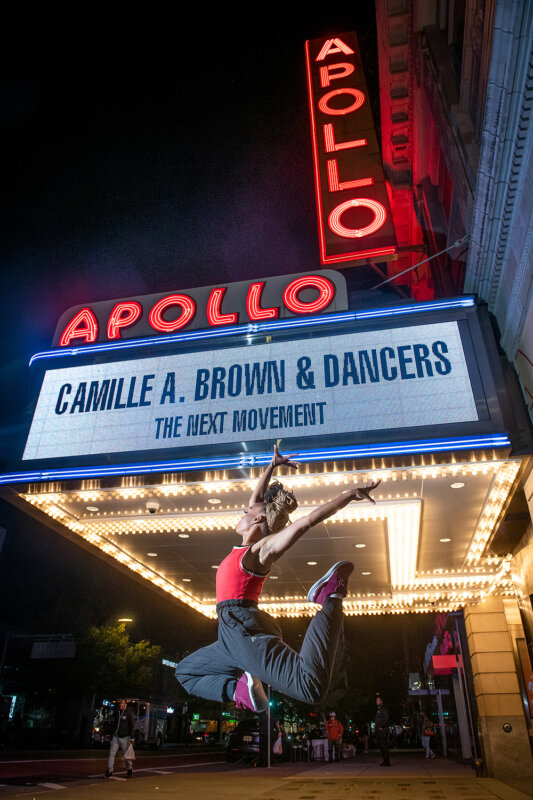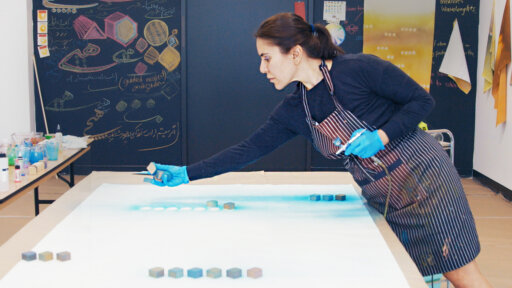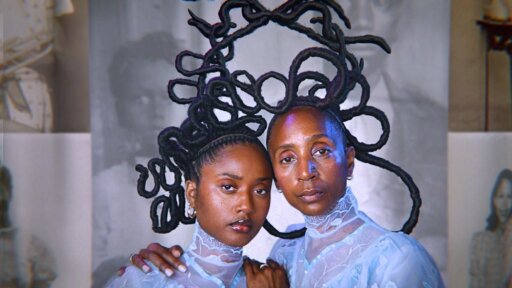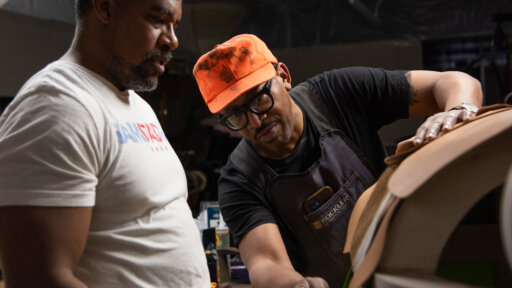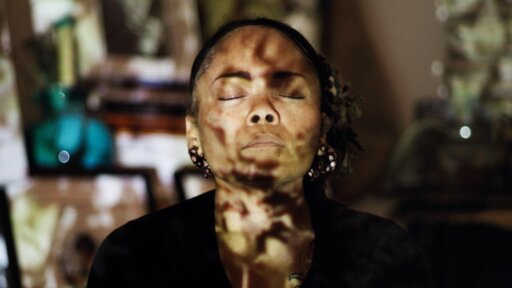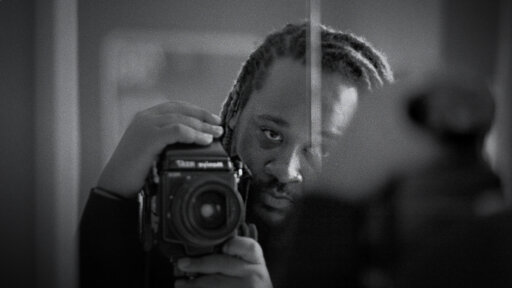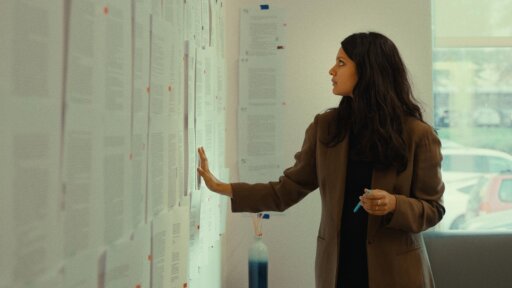Camille A. Brown: Giant Steps is part of In The Making, a documentary shorts series from American Masters and Firelight Media follows emerging cultural icons on their journeys to becoming masters of their artistic disciplines.
Michelle Parkerson’s co-director statement
My initial awareness of Camille A. Brown began in 2001, seeing her in the groundbreaking ensemble, Ronald K. Brown/EVIDENCE. She dominated my attention for the entire performance. Camille’s boundless stage presence and fearless spirit led me to follow her burgeoning career and here the connectivity between filmmaker and documentary subject began.
My directing journey has focused on documenting stories of fiercely innovative, path-breaking Black women artists – jazz legend Betty Carter, a cappella changemakers Sweet Honey in the Rock, Black Lesbian author and firebrand, Audre Lorde. Add to these chronicles of extraordinary women and their achievements, Camille A. Brown: Giant Steps.
This film is an impactful profile of a current-generation dance luminary on our culture.
Since the evolution of her own dance company, Camille A. Brown and Dancers, in 2006, Camille’s creative expansion appears in films, Broadway shows, performances at The Joyce, The Apollo Theater, The Metropolitan Opera, in her Tony-nominated Choreography for the Alicia Keys Broadway musical, “Hell’s Kitchen,” and most recently in her Tony-nominated Choreography for “Gypsy.” She made history as the first Black woman to direct and choreograph a Broadway musical in 65 years (since Katherine Dunham) with the 2022 Broadway revival of Ntozake Shange’s “for colored girls who have considered suicide/when the rainbow is enuf”.
Key to Camille’s accumulating successes are the brilliance and power of her vision, which she simply describes as “…it’s Camille”. But it is, in fact, an act of revolution she is performing – redefining how African American and women’s stories are told, exploding stereotypes, transforming images and keepin’ it real – one Giant Step at a time.
Shellée M. Haynesworth co-director statement
Producing and co-directing Camille A. Brown: Giant Steps was an incredibly inspiring and fruitful filmmaking experience. I’m delighted that our film authentically showcases Camille A. Brown, a five-time Tony Award-nominated choreographer, director and artistic director, offering a wellspring into her dynamic, rising career. Her work, which blends contemporary movement with Africanist aesthetics, creates a powerful narrative of Black empowerment, resilience, and community. Capturing Camille’s groundbreaking journey in just 15 minutes was both a privilege and a challenge, reflecting her extensive influence beyond the stage. Brown’s choreography goes beyond physical movement to explore the rich tapestry of stories and histories embedded in each performance.
Drawing from African, Caribbean, and American cultural traditions, her work delves deeply into Black identity and heritage.
Our film examines how Camille’s background and personal experiences shape her choreography. Through interviews with Camille, her mother, mentors, and collaborators, we reveal how her work challenges conventional dance narratives and amplifies underrepresented voices. Employing a cinéma-vérité approach with hand-held shooting, we mirrored the dynamism and intensity of her choreography, conveying its rhythmic and emotional complexity. Camille A. Brown: Giant Steps not only documents Camille’s artistic contributions but also celebrates dance as a vital platform for cultural expression and personal reflection. I hope viewers will appreciate Camille’s impact on the dance community and recognize the critical importance of “amping up” support of the arts for future generations.
More about Camille A. Brown
Camille A. Brown is a prolific Black choreographer whose work taps into both ancestral and contemporary stories to capture a range of deeply personal experiences and cultural narratives of African American identity. Through the medium of dance, she is successfully balancing careers in Stage, TV, and Film. She is the Artistic Director and Choreographer for her company, Camille A. Brown & Dancers.
Her trilogy on race, culture, and identity has won accolades: “Mr. TOL E. RAncE” (2012) was honored with a Bessie Award in 2014, and a Bessie Award nomination for Outstanding Revival; “BLACK GIRL: Linguistic Play” (2015) was Bessie-nominated; and “ink” (2017) premiered at The Kennedy Center, was performed at The Apollo Theater in 2022, and has received critical acclaim.
In 2022, she made her Broadway directorial debut for the Broadway revival of “for colored girls who have considered suicide/when the rainbow is enuf,” making her the first Black woman to direct and choreograph a Broadway play since Katherine Dunham in 1955. The production received seven Tony Award nominations including Best Direction of a Play and Best Choreography for Brown. The New York Times proclaimed the production “triumphant.” Brown received the 2022 Drama League Award Nomination for Best Direction and the show received a nomination for Outstanding Revival of a Play. Brown also received the 2023 Broadway Black Award for Best Direction. Within the same season, Brown became the first Black artist at The Metropolitan Opera to direct a mainstage production, co-directing alongside James Robinson on Terence Blanchard’s “Fire Shut Up in My Bones” (2021), which she also choreographed.
Brown’s first musical for theater was “The Fortress of Solitude” directed by Daniel Aukin, written for stage by Itamar Moses, and with music & lyrics by Michael J. Friedman. Her Broadway choreography debut was with “A Streetcar Named Desire,” followed by the Tony Award-winning musical, “Once on This Island.” Brown has been nominated for five Tony awards including for “Choir Boy,” “for colored girls who have considered suicide/when the rainbow is enuf,” “Hell’s Kitchen,” with music and lyrics written by Alicia Keys, and “Gypsy.” For “Hell’s Kitchen,” she also received her fourth Drama Desk nomination and won The Chita Rivera Award for Outstanding Choreography and the Audelco Award for Best Choreographer.
Brown’s film and TV work includes “Harlem” (seasons 1 & 3, Amazon Prime), “Ma Rainey’s Black Bottom” (Netflix); Emmy award-winning “Jesus Christ Superstar Live” (NBC); New Year’s Eve in Rockefeller Center (NBC), and Google Arts & Culture (“ink”).
Brown’s early training began at Bernice Johnson’s Cultural Arts Center, Devore Dance Center, and Fiorello LaGuardia High School. She received her BFA from The University of North Carolina School of the Arts. After graduation, she joined Ronald K. Brown/EVIDENCE, A Dance Company, where she danced from 2001-2006.
She returned to Broadway this past November for the revival of “Gypsy,” directed by George C. Wolfe and starring Audra McDonald. This is the first time new choreography has been done for a main stem production. Her work was hailed as “a brilliant stroke of choreography” (USA Today) and “a consistent, inventive charm.” (Daily Beast). Brown received a Drama Desk Award Nomination as well as her fifth Tony Nomination for her original choreography in this production.


